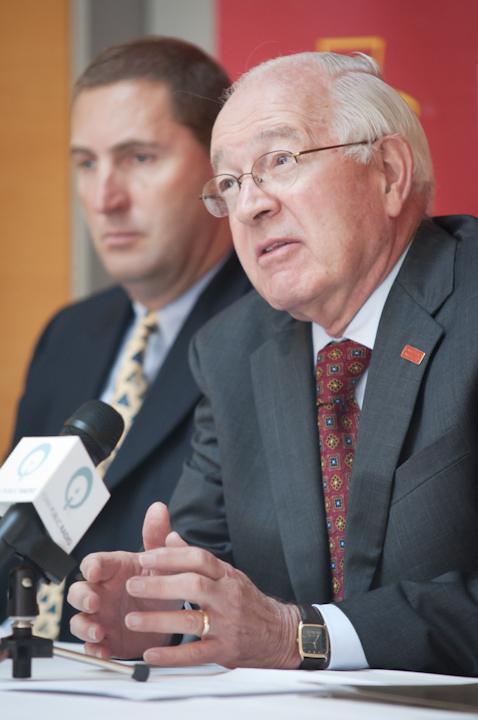University officials address flood recovery
August 19, 2010
Just over one week ago, Ames was inundated with record amounts of flood water.
Now, it is still early in the recovery process for Iowa State.
“This recovery process is certainly going to take awhile; certainly well into the fall semester, and in some areas much beyond that,” ISU President Gregory Geoffroy said in a news conference Thursday morning.
Geoffroy addressed the media along with Director of Athletics Jamie Pollard, Vice President for Business and Finance Warren Madden and Director of Facilities Planning and Management David Miller.
None of the officials would offer estimates of financial damages or a timeline for the recovery.
Madden said the university’s next steps involve discussing damage with insurance carriers and FEMA.
“We do not have an actual estimate of the damage yet,” Madden said. “I expect next week as we begin working with FEMA we will be arriving at that point. It certainly is in the millions of dollars, but I’m not prepared today to give you an exact number.”
Madden said most of the damaged facilities should fall well within their insurance coverage, while buildings such as Hilton Coliseum would likely exceed their limits.
Of the buildings that were flooded, Madden said Hilton would be the university’s first priority due to the nature of its uses. Madden and Pollard alluded to having other options to relocate the ISU soccer and volleyball teams from their damaged facilities, but would not have as many viable options once the men’s and women’s basketball seasons roll around in November.
According to a flood map released by the university Thursday, Aug. 19, 25 buildings on campus were affected just by rainfall and storms alone, aside from five buildings that had standing water inside due to flooding.
Some of the buildings that were damaged during storms include the Durham Center, Carver Hall, Lagomarcino Hall and Kildee Hall. Miller said the two buildings most greatly impacted were Hamilton Hall and Horticulture Hall. Miller said that most of the buildings on campus were cleaned by university personnel, mostly drying and removing the water from the buildings.
However, Geoffroy and Madden both asserted that none of the damage to campus buildings will have a noticeable impact when classes begin Monday.
Going forward, no plans for future prevention have been discussed yet.
“We do need to assess what can we do to keep these kinds of things from happening again in the future?” Madden said. “That will involve hiring those kinds of professional consultants.”
Madden said the university thought it took significant steps toward avoiding flood damage after both major floods in 1993 and 2008.
“Water is a very powerful force, and when it moves like it did Tuesday night into Wednesday morning, it penetrated a number of these facilities in places that had not had problems before,” Madden said.
Both Madden and Pollard alluded to the possibility of renovation to damaged facilities alongside repair and restoration.
Madden said the university was fortunate the flooding did not occur while classes were in session. However, there was an estimate that 47 students were left without a home after 27 apartments flooded in the University Village.
Those students were relocated to other apartments in the area, but some students have also been relocated to Wilson Hall, south of campus.







